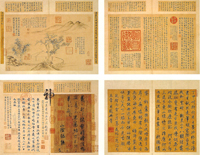AVOID HARMFUL CONDITIONS
Most artworks are susceptible to deterioration from light, humidity, temperature, insects, dust, salt and vibration as well as the dents, knocks, chips and tears that come from contact with human beings. Therefore, keep your scroll painting out of direct sunlight and reduce artificial lighting where possible
• Humidity: keep your scroll paintings in humidity between 40%-60%, avoid fluctuating changes in humidity to reduce the possibilities of mold and insect damage.
• Temperature: avoid extreme of temperature change in the space where your artwork is on display
• Dust: keep artwork free of dust. Dust on the surface of a painting on silk or rice paper with a soft cloth or feather if necessary
• Salt: In the air encourages corrosion. Use air conditioner to reduce the danger
• Vibration: avoid transporting scroll painting without compensating for vibration by careful packing and support
• Contact with Human: avoid touching the surface of a scroll painting with the hands, which will speed the color deterioration
• Presentation and Storage: Hanging the painting on interior walls rather than exterior wall, and place it on a flat, dry and pest-free surface if not hanging.
DECISION ON RESTORATION
Before commissioning a conservation or restoration treatment, owners should have some basic knowledge of restoration about what can be and what cannot be done. A preventive treatment could (most of the time) avoid future more invasive treatment on a painting.
In regard to condition, the more restoration, the lower the value of the piece. A bad restoration treatment will decrease the economic value of a painting. To undo a previous restoration is equally risky, since the reversed restoration may bring more physical harm to the already damaged painting. In other words, the economic value of a reversed restored work would be even lower than the actual price a painting with some visible condition signs.
DON'T DELAY RESTORATION
If the needed conservation is postponed, the greater harm the physical damage brings to the object, and the greater the loss in value in all aspects. In a short amount of time, not having a painting conserved may have been the best decision regarding loss in value for insurance purpose. However, after only a few years, the painting would have suffered irreversible damage.
If a conservation and restoration is necessary, consulting a qualified Asian art scroll restorer before executing the conservation is wise. Owners should start with a conservation proposal from a conservation specialist or a lab. The proposal must detail what would be most appropriate to treat the damaged painting and the extent of the conservation, the restoration cost vs. the replacement cost. Owners must understand the limitations and consequences of conservation and restoration, whether it will look as if it had never been damaged, or if that outcome is simply not possible because the piece has gone through too much and some traces are not erasable.

